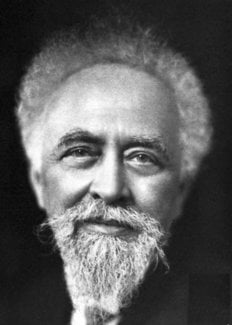Jean Baptiste Perrin
Biographical

Jean Baptiste Perrin was born in Lille, September 30, 1870, where he was educated at the École Normal Supérieure, becoming an assistant in physics during 1894-1897, when he began his researches on cathode rays and X-rays. He received the degree of “docteur ès sciences” in 1897 for a thesis on cathode and Röntgen rays and was appointed, in the same year, to a readership in physical chemistry at the Sorbonne, University of Paris. He became Professor here in 1910; a post which he held till 1940, when the Germans invaded his country.
His earliest work was on the nature of cathode rays, and their nature was proved by him to be that of negatively charged particles. He also studied the effect of the action of X-rays on the conductivity of gases. In addition, he worked on fluorescence, the disintegration of radium, and the emission and transmission of sound. The work for which he is best known is the study of colloids and, in particular, the so-called Brownian movement. His results in this field were able to confirm Einstein’s theoretical studies in which it was shown that colloidal particles should obey the gas laws, and hence to calculate Avogadro’s number N, the number of molecules per grammolecule of a gas. The value thus calculated agreed excellently with other values obtained by entirely different methods in connection with other phenomena, such as that found by him as a result of his study of the sedimentation equilibrium in suspensions containing microscopic gamboge particles of uniform size. In this way the discontinuity of matter was proved by him beyond doubt: an achievement rewarded with the 1926 Nobel Prize.
Perrin was the author of many books and scientific papers. His book Les Atomes, published in 1913, sold 30,000 copies up to 1936. His principal papers were: “Rayons cathodiques et rayons X” (Cathode rays and X-rays), Ann. Phys., 1897; Les Principes (The principles), Gauthier-Villars, 1901; “Electrisation de contact” (Contact electrificaton), J. Chim. Phys., 1904-1905; “Réalité moléculaire” (Molecular reality), Ann. Phys., 1909; “Matière et Lumière” (Matter and light), Ann. Phys., 1919; “Lumière et Reaction chimique” (Light and chemical reaction), Conseil Solvay de Chimie, 1925.
Many honours were conferred on him for his scientific work; the Joule Prize of the Royal Society in 1896, the Vallauri Prize of Bologna in 1912 and, in 1914, the La Caze Prize of the Paris Academy of Sciences.
He held honorary doctorates of the Universities of Brussels, Liege, Ghent, Calcutta, New York, Princeton, Manchester, and Oxford. He was twice appointed a member of the Solvay Committee at Brussels in 1911 and in 1921. He held memberships of the Royal Society (London) and of the Academies of Sciences of Belgium, Sweden, Turin, Prague, Rumania, and China. In 1923 he was elected to the French Academy of Sciences. He became a Commander of the Legion of Honour in 1926, and was also made Commander of the British Empire and of the Order of Leopold (Belgium).
Perrin was the creator of the Centre National de la Recherche Scientifique, an organization offering to most promising French scientists – whose scientific talents would otherwise be lost – a career outside the University. It was due to this institute that Frédéric Joliot could carry out his magnificent investigations. In addition to this, he founded the Palais de la Découverte (Palace of discovery); he was also responsible for the establishment of the Institut d’Astrophysique, in Paris, and for the construction of the large Observatoire de Haute Provence; without his prestige and his power of persuasion the Institut de Biologie Physico-Chimique would never have come into being.
Perrin was an officer in the engineer corps during the 1914-1918 War. When the Germans invaded his country in 1940 he escaped to the U.S.A., where he died on the 17th of April, 1942. After the War, in 1948, his remains were transferred to his fatherland by the battleship Jeanne d’Arc, and buried in the Panthéon.
This autobiography/biography was written at the time of the award and first published in the book series Les Prix Nobel. It was later edited and republished in Nobel Lectures. To cite this document, always state the source as shown above.
The Nobel Foundation's copyright has expired.Nobel Prizes and laureates
Six prizes were awarded for achievements that have conferred the greatest benefit to humankind. The 14 laureates' work and discoveries range from quantum tunnelling to promoting democratic rights.
See them all presented here.
